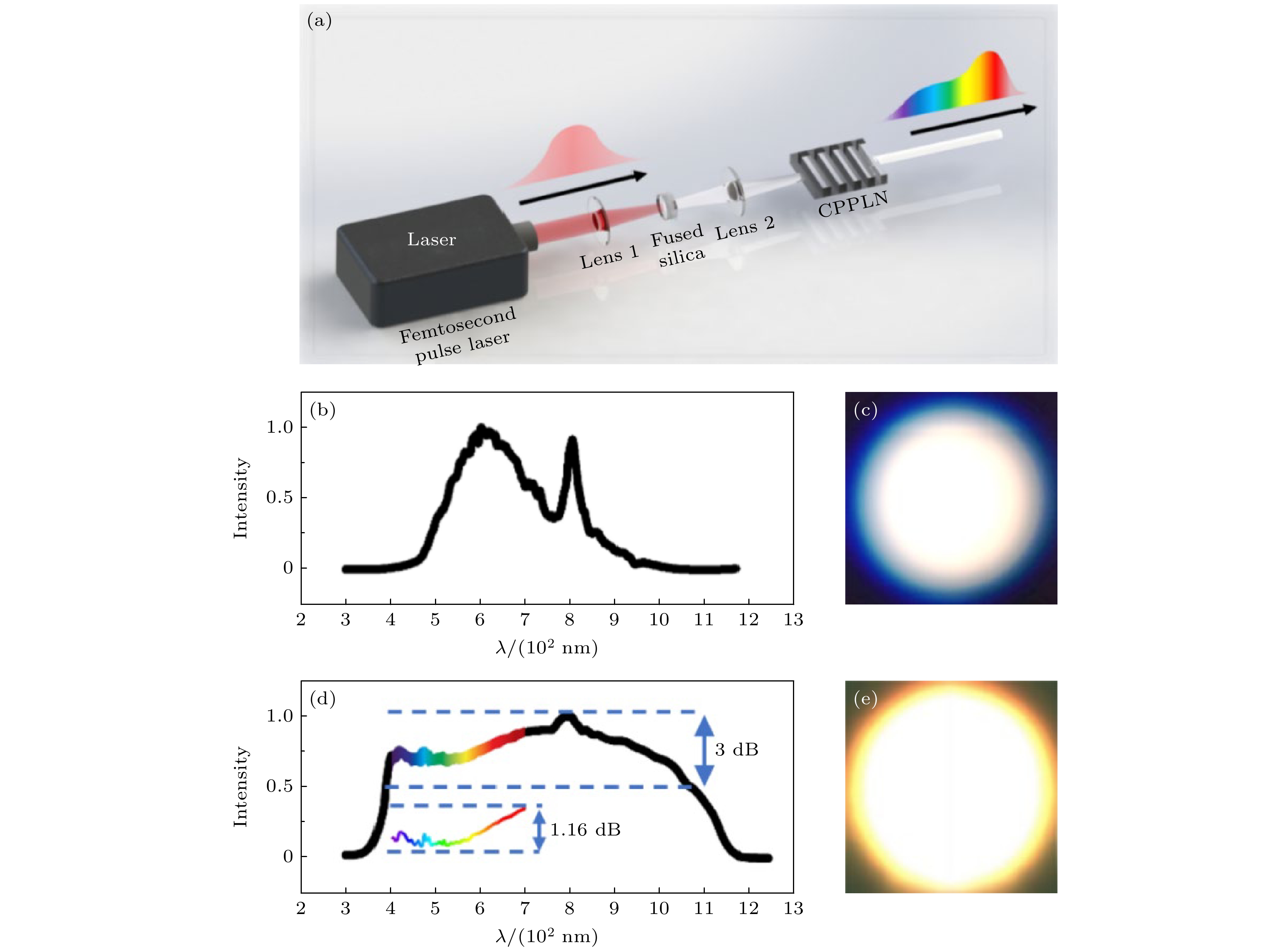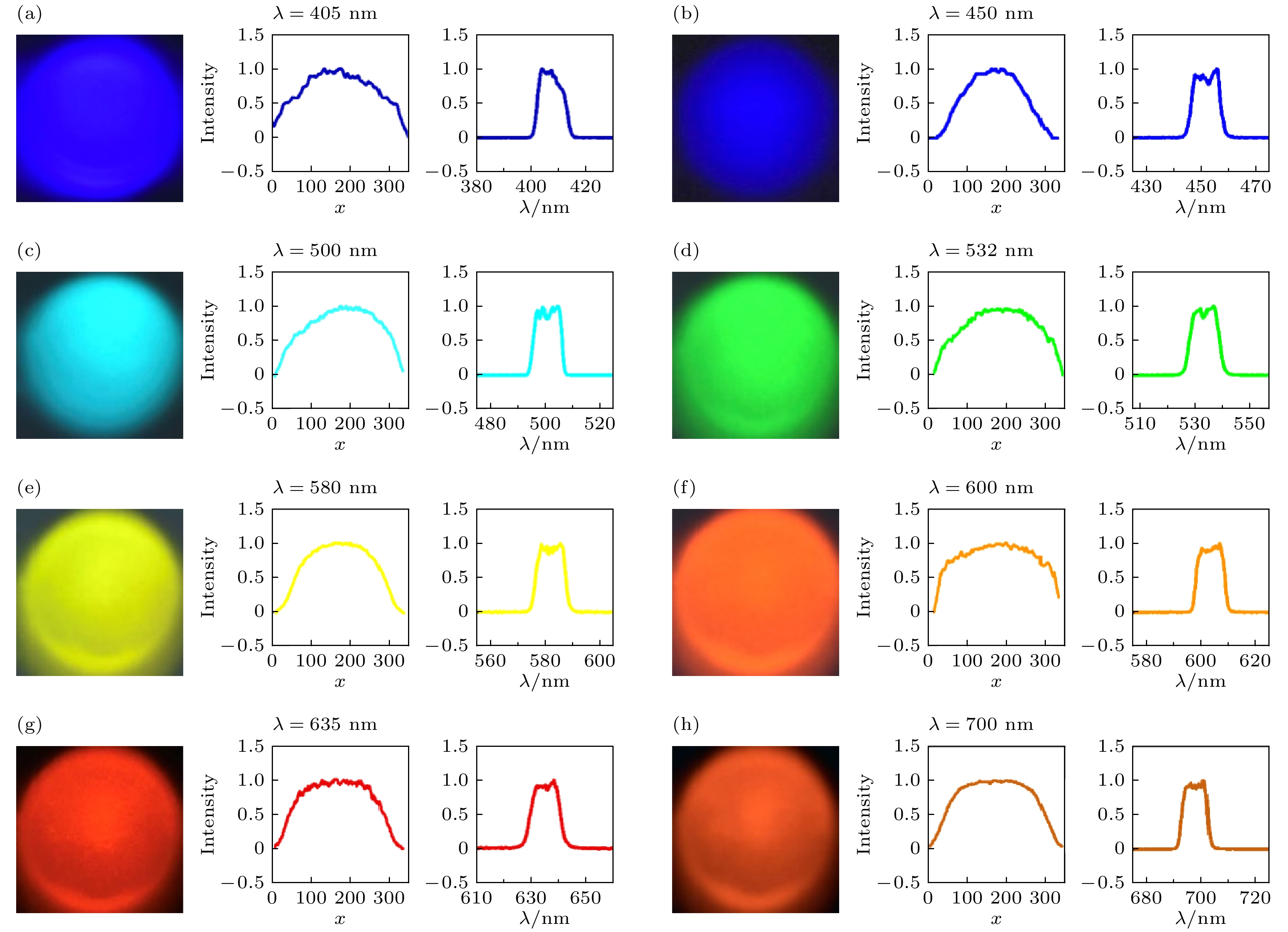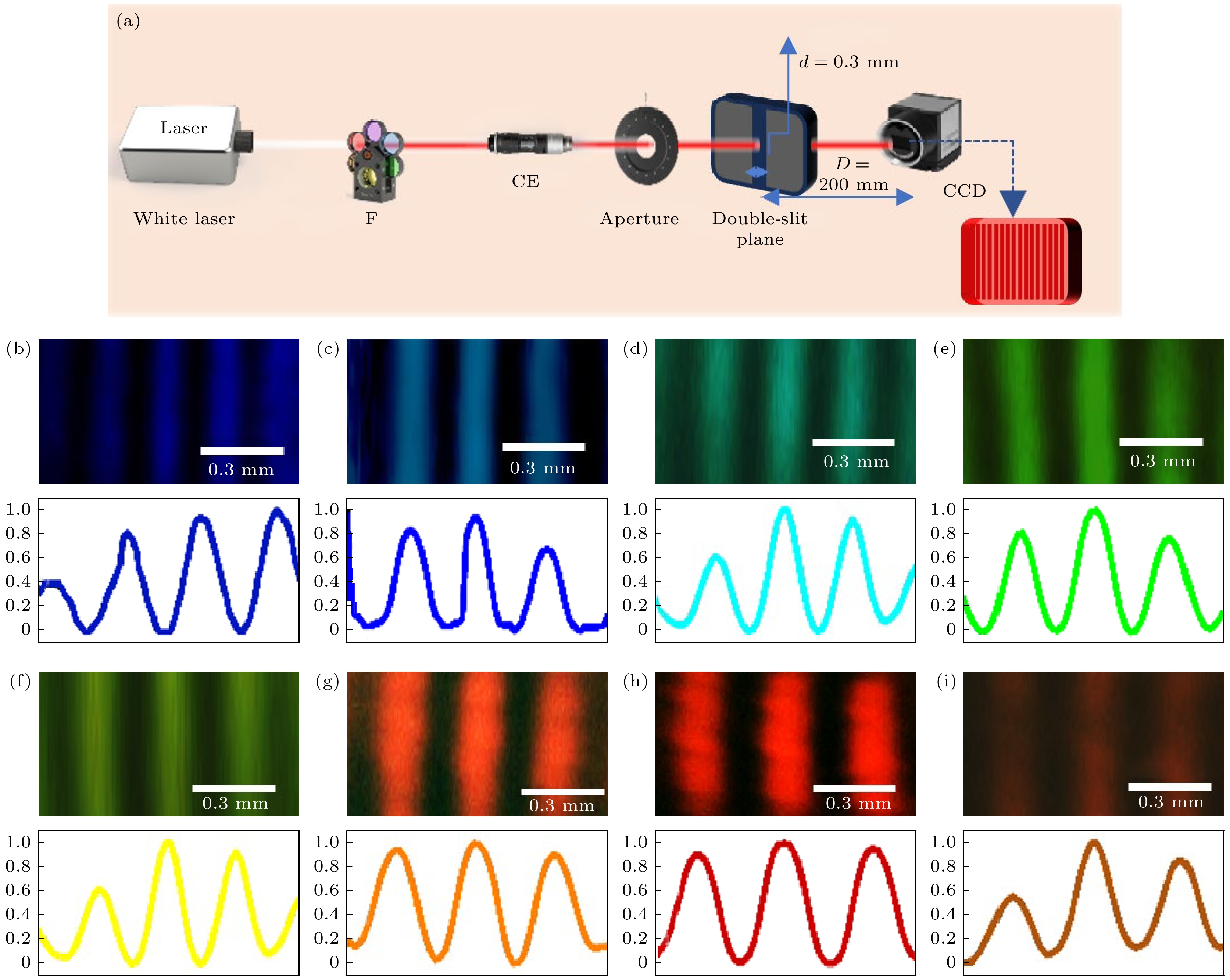-
白光通常被认为是非相干的, 然而, 近年来广受关注的超连续激光白激光具有激光强度高、相干性好的特点, 挑战了这一局限性. 尽管白激光已经被提出并在技术上得到了广泛的发展, 但对其光波性能, 尤其是空间相干性的具体分析却十分缺乏, 这在一定程度上限制了其实际应用. 本文对课题组2023年自主研制的由高强度飞秒激光通过二阶、三阶非线性效应展宽谱带所产生的高强度、超平坦谱带白激光开展了波前强度、偏振特性以及空间相干性的详细实验研究和分析. 通过使用带通滤波片从白激光中提取多个分量, 利用杨氏双缝干涉仪测量干涉条纹的对比度, 以评估其空间相干性. 实验结果显示, 白激光的波前强度呈准高斯分布, 光斑均匀, 是线偏振光. 白激光在杨氏双缝干涉仪中产生的可见光波段平均干涉条纹对比度是0.77, 表明其具有优异的空间相干性. 本研究将为白色激光在彩色全息、白光干涉仪表面层析、显微成像及其他需要具有一定相干性的白光的应用领域提供有价值的指导.
White light is typically considered incoherent; however, the recently popular supercontinuum laser, also known as white laser, spans the visible spectrum and features high laser intensity and good coherence, challenging this traditional limitation. The white laser has a wide range of applications, including multi-channel confocal microscopy, color holography, and white light interferometric surface topography. Although white lasers have been proposed and developed extensively in terms of technology, specific analyses of their optical wave properties—especially spatial coherence—are still lacking. Since many applications impose certain requirements on the spatial coherence of white light, the lack of research into the spatial coherence of white lasers has, to some extent, limited their practical use. This paper presents a detailed experimental study and analysis of the wavefront intensity, polarization characteristics, and spatial coherence of the high-intensity ultra-flat spectrum white laser that was independently developed by our research group in 2023. The laser is generated by broadening the spectrum of a high-intensity Ti:sapphire femtosecond laser through second- and third-order nonlinear effects. A bandpass filter is used to extract eight components from the white laser, with a central wavelength range from 405 nm to 700 nm and a bandwidth of 10 nm for each component. By measuring the performance of these eight quasi-monochromatic lasers, the characteristics of the white laser of the entire visible spectrum can be evaluated. The CCD imaging of the collimated quasi-monochromatic laser spots reveals that their wavefront intensities exhibit a quasi-Gaussian distribution with uniform beam profiles. Polarization measurements by using polarizers at various angles show that the white laser is linearly polarized. A Young’s double-slit interferometer is used to measure the interference fringe contrast of the eight quasi-monochromatic beams to assess their spatial coherence. The experimental results show that the average interference fringe contrast of the entire visible spectrum is 0.77, and the difference between different wavelengths is very small.This indicates that the white laser has excellent spatial coherence in the visible range. The eight quasi-monochromatic lasers in the visible spectrum all exhibit quasi-Gaussian wavefront intensity distributions, linear polarization, and high spatial coherence. This indicates that the white laser inherits the excellent properties of the Ti:sapphire laser. All of these data provide valuable guidance for the application of white lasers in color holography, white light interferometric surface tomography, microscopic imaging, and other fields that require white light with a certain degree of coherence. -
Keywords:
- white laser /
- spatial coherence /
- interference fringe visibility
[1] Alfano R R 1990 Appl. Opt. 29 1242
 Google Scholar
Google Scholar
[2] Alfano R R, Shapiro S L 1970 Phys. Rev. Lett. 24 592
 Google Scholar
Google Scholar
[3] Fork R L, Tomlinson W J, Shank C V, Hirlimann C, Yen R, Tomlinson W J 1983 Opt. Lett. 8 1
 Google Scholar
Google Scholar
[4] Froehly L, Meteau J 2012 Opt. Fiber Technol. 18 411
 Google Scholar
Google Scholar
[5] Travers J C, Grigorova T F, Brahms C, Belli F 2019 Nat. Photonics 13 547
 Google Scholar
Google Scholar
[6] Elu U, Maidment L, Vamos L, Tani F, Novoa D, Frozs H, Badikov V, Badikov D, Petrov V, Russell J, Biegert J 2021 Nat. Photonics 15 277
 Google Scholar
Google Scholar
[7] Schliesser A, Picqué N, Hänsch T W 2012 Nat. Photonics 6 440
 Google Scholar
Google Scholar
[8] Udem Th, Holzwarth R, Hänsch T W 2002 Nature 416 233
 Google Scholar
Google Scholar
[9] Petersen C R, Møller U, Kubat I, Zhou B, Dupont S, Ramsay J, Benson T, Sujecki S, Abdel-Moneim N, Tang Z, Furniss D, Seddon A, Bang O 2014 Nat. Photonics 8 830
 Google Scholar
Google Scholar
[10] Jiang X, Joly N Y, Finger M A, Babic F, Wong K L, Travers J C, Russell J 2015 Nat. Photonics 9 133
 Google Scholar
Google Scholar
[11] He P, Liu Y Y, Zhao K, Teng H, He X K, Huang P, Huang H D, Zhong S Y, Jiang Y J, Fang S B, Hou X, Wei Z Y 2017 Opt. Lett. 42 474
 Google Scholar
Google Scholar
[12] Mollenauer L F, Stolen R H, Gordon J P, Tomlinson W J 1983 Opt. Lett. 8 289
 Google Scholar
Google Scholar
[13] Hassan M T, Luu T T, Moulet A, Raskazovskaya O, Zhokhov P, Garg M, Karpowicz N, Zheltikov A M, Pervak V, Krausz F, Goulielmakis E 2016 Nature 530 66
 Google Scholar
Google Scholar
[14] Chen B Q, Ren M L, Liu R J, Zhang C, Sheng Y, Ma B Q, Li Z Y 2014 Light Sci. Appl. 3 e189
 Google Scholar
Google Scholar
[15] Chen B Q, Zhang C, Hu C Y, Liu R J, Li Z Y 2015 Phys. Rev. Lett. 115 083902
 Google Scholar
Google Scholar
[16] Chen B Q, Hong L H, Hu C Y, Li Z Y 2021 Research 2021 1539730
 Google Scholar
Google Scholar
[17] Li M Z, Hong L H, Li Z Y 2022 Research 2022 9871729
 Google Scholar
Google Scholar
[18] Hong L H, Hu C, Liu Y Y, He H J, Liu L Q, Wei Z Y, Li Z Y 2023 PhotoniX 4 11
 Google Scholar
Google Scholar
[19] Hong L H, Liu L Q, Liu Y Y, Qian J Y, Feng R Y, Li W K, Li Y Y, Peng Y J, Leng Y X, Li R X, Li Z Y 2023 Light Sci. Appl. 12 199
 Google Scholar
Google Scholar
[20] Hong L H, Yang H Y, Li Z Y 2023 Research 6 0210
 Google Scholar
Google Scholar
[21] Knapp T, Lima N, Daigle N, Duan S, Merchant J L, Sawyer T W 2024 J. Biomed. Opt. 29 016007
 Google Scholar
Google Scholar
[22] Hassan M A 2025 Appl. Opt. 64 654
 Google Scholar
Google Scholar
[23] Shimobaba T, Ito T 2003 Opt. Rev. 10 339
 Google Scholar
Google Scholar
[24] Kueny E, Meier J, Levecq X, Varkentina N, Kärtner F X, Calendron L 2018 Opt. Express 26 31299
 Google Scholar
Google Scholar
[25] Genty G, Friberg A T, Turunen J 2016 Prog. Opt. 61 71
 Google Scholar
Google Scholar
[26] Melnik M V, Tcypkin A N, Kozlov S A 2018 Rom. J. Phys. 63 203
[27] Zeylikovich I, Alfano R R 2003 Appl. Phys. B 77 265
 Google Scholar
Google Scholar
[28] Su Y B, Fang S B, Gao Y T, Zhao K, Chang G Q, Wei Z Y 2021 Appl. Phys. Lett. 118 261102
 Google Scholar
Google Scholar
[29] Wang P, Huang J, Xie S, Troles J, Russell J 2021 Photon. Res. 9 630
 Google Scholar
Google Scholar
[30] Zhu X, Zhao D, Zhang B, Yang L Y, Yang Y K, Liu S, Hou J 2023 Opt. Express 31 13182
 Google Scholar
Google Scholar
[31] Chang K Y, Chen G Y, Yu H C, Liu J M 2023 Opt. Commun. 533 129281
 Google Scholar
Google Scholar
[32] 冯柳宾, 鲁欣, 刘晓龙, 葛绪雷, 马景龙, 李玉同, 陈黎明, 董全力, 王伟民, 滕浩, 王兆华, 盛政明, 魏志义, 贺端威, 张杰 2012 61 174206
 Google Scholar
Google Scholar
Feng L B, Lu X, Liu X L, Ge X L, Ma J L, Li Y T, Chen L M, Dong Q L, Wang W M, Teng H, Wang Z H, Sheng Z M, Wei Z Y, He D W, Zhang J 2012 Acta Phys. Sin. 61 174206
 Google Scholar
Google Scholar
-
图 2 白激光的产生原理和基本信息 (a) 产生飞秒白激光的光路图, 该激光通过高强度钛宝石飞秒脉冲激光束经过熔融石英-CPPLN二阶与三阶非线性协同频率转换模块产生; (b)经过熔融石英平板后的光谱测量结果; (c) 经过熔融石英平板后的激光光斑; (d) 白激光的测量光谱, 展现出超平坦的光谱特性, 其中彩色带表示可见光范围, 其放大图显示在插图中; (e) 系统最终输出的白激光的光斑
Fig. 2. Basic information of the white laser: (a) Schematic diagram of a homemade femtosecond white laser created by sending an intense Ti:sapphire femtosecond pulse laser beam through a fused silica-CPPLN 2nd-NL and 3rd-NL synergistic nonlinear frequency conversion module. (b) The measured spectrum of the light after the fused silica plate. (c) The spot of the laser after the fused silica plate. (d) The measured spectrum of the white laser shows the ultra-flat spectral profile. The color band represents the visible range, whose enlarged view is shown in the inset. (e) The spot of the white laser beam.
图 3 波前强度分析, 即白激光通过中心波长分别为(a) 405 nm, (b) 450 nm, (c) 500 nm, (d) 532 nm, (e) 580 nm, (f) 600 nm, (g) 635 nm, (h) 700 nm, 带宽为 10 nm 的滤波片后, 不同光谱成分的波前强度(左)、线强度分布(中)和光谱分布(右)
Fig. 3. Wavefront analysis. Wavefront (left), line profile (center), and spectral profile (right) of the white laser at different spectral components in the visible band when it passes through 10 nm bandwidth filters centering at the wavelength of (a) 405 nm, (b) 450 nm, (c) 500 nm, (d) 532 nm, (e) 580 nm, (f) 600 nm, (g) 635 nm, and (h) 700 nm
图 4 杨氏双缝实验的实验结果 (a)杨氏双缝实验的光路图, 其中F为带有不同滤波片的可旋转支架, CE为光束准直扩束系统; (b)—(i) 八种波长的干涉条纹和强度线轮廓图, 其中(b) λ = 405 nm, $ \upsilon $ = 0.86; (c) λ = 450 nm, $ \upsilon $ = 0.86; (d) λ = 500 nm, $ \upsilon $ = 0.75; (e) λ = 532 nm, $ \upsilon $ = 0.82; (f) λ = 580 nm, $ \upsilon $ = 0.77; (g) λ = 600 nm, $ \upsilon $ = 0.62; (h) λ = 635 nm, $ \upsilon $ = 0.80; (i) λ = 700 nm, $ \upsilon $ = 0.67
Fig. 4. Experimental results in the Young’s double-slit experiment: (a) The architecture of Young’s double-slit experiment, where F represents rotatable holder embedded with different filters, CE represents collimated beam expanding system; (b)—(i) the interference fringes and intensity line profile of the eight wavelengths, where (b) λ = 405 nm, $ \upsilon $ = 0.86; (c) λ = 450 nm, $ \upsilon $ = 0.86; (d) λ = 500 nm, $ \upsilon $ = 0.75; (e) λ = 532 nm, $ \upsilon $ = 0.82; (f) λ = 580 nm, $ \upsilon $ = 0.77; (g) λ = 600 nm, $ \upsilon $ = 0.62; (h) λ = 635 nm, $ \upsilon $ = 0.80; (i) λ = 700 nm, $ \upsilon $ = 0.67.
表 1 从白激光中提取光波所使用的滤波片的中心波长和带宽
Table 1. Central wavelength and bandwidth of the filter used to extract the light wave from the white laser.
Wavelength/nm 405 450 500 532 580 600 635 700 Bandwidth/nm 10 10 10 10 10 10 10 10 表 2 各准单色光经过滤波片后功率随偏振片角度的变化
Table 2. Power variation with polarizer angle for each quasi-monochromatic light after filtering.
$ \lambda /{\mathrm{n}}{\mathrm{m}} $ 405 450 500 532 580 600 635 700 $ {I}_{{\mathrm{max}}} /{\mathrm{\mu }}{\mathrm{W}} $ 43.7 42.5 43.5 40.1 45.7 46.8 45.0 46.2 $ {\theta }_{{\mathrm{max}}}/({}^\circ) $ 0 0 1 0 1 0 0 0 $ {I}_{{\mathrm{min}}} $/$ {{\mu}}{\mathrm{W}} $ 0.2 0.2 0.1 0.1 0.2 0.2 0.2 0.2 $ {\theta }_{{\mathrm{min}}}/({}^\circ) $ 90 90 89 90 89 90 90 90 -
[1] Alfano R R 1990 Appl. Opt. 29 1242
 Google Scholar
Google Scholar
[2] Alfano R R, Shapiro S L 1970 Phys. Rev. Lett. 24 592
 Google Scholar
Google Scholar
[3] Fork R L, Tomlinson W J, Shank C V, Hirlimann C, Yen R, Tomlinson W J 1983 Opt. Lett. 8 1
 Google Scholar
Google Scholar
[4] Froehly L, Meteau J 2012 Opt. Fiber Technol. 18 411
 Google Scholar
Google Scholar
[5] Travers J C, Grigorova T F, Brahms C, Belli F 2019 Nat. Photonics 13 547
 Google Scholar
Google Scholar
[6] Elu U, Maidment L, Vamos L, Tani F, Novoa D, Frozs H, Badikov V, Badikov D, Petrov V, Russell J, Biegert J 2021 Nat. Photonics 15 277
 Google Scholar
Google Scholar
[7] Schliesser A, Picqué N, Hänsch T W 2012 Nat. Photonics 6 440
 Google Scholar
Google Scholar
[8] Udem Th, Holzwarth R, Hänsch T W 2002 Nature 416 233
 Google Scholar
Google Scholar
[9] Petersen C R, Møller U, Kubat I, Zhou B, Dupont S, Ramsay J, Benson T, Sujecki S, Abdel-Moneim N, Tang Z, Furniss D, Seddon A, Bang O 2014 Nat. Photonics 8 830
 Google Scholar
Google Scholar
[10] Jiang X, Joly N Y, Finger M A, Babic F, Wong K L, Travers J C, Russell J 2015 Nat. Photonics 9 133
 Google Scholar
Google Scholar
[11] He P, Liu Y Y, Zhao K, Teng H, He X K, Huang P, Huang H D, Zhong S Y, Jiang Y J, Fang S B, Hou X, Wei Z Y 2017 Opt. Lett. 42 474
 Google Scholar
Google Scholar
[12] Mollenauer L F, Stolen R H, Gordon J P, Tomlinson W J 1983 Opt. Lett. 8 289
 Google Scholar
Google Scholar
[13] Hassan M T, Luu T T, Moulet A, Raskazovskaya O, Zhokhov P, Garg M, Karpowicz N, Zheltikov A M, Pervak V, Krausz F, Goulielmakis E 2016 Nature 530 66
 Google Scholar
Google Scholar
[14] Chen B Q, Ren M L, Liu R J, Zhang C, Sheng Y, Ma B Q, Li Z Y 2014 Light Sci. Appl. 3 e189
 Google Scholar
Google Scholar
[15] Chen B Q, Zhang C, Hu C Y, Liu R J, Li Z Y 2015 Phys. Rev. Lett. 115 083902
 Google Scholar
Google Scholar
[16] Chen B Q, Hong L H, Hu C Y, Li Z Y 2021 Research 2021 1539730
 Google Scholar
Google Scholar
[17] Li M Z, Hong L H, Li Z Y 2022 Research 2022 9871729
 Google Scholar
Google Scholar
[18] Hong L H, Hu C, Liu Y Y, He H J, Liu L Q, Wei Z Y, Li Z Y 2023 PhotoniX 4 11
 Google Scholar
Google Scholar
[19] Hong L H, Liu L Q, Liu Y Y, Qian J Y, Feng R Y, Li W K, Li Y Y, Peng Y J, Leng Y X, Li R X, Li Z Y 2023 Light Sci. Appl. 12 199
 Google Scholar
Google Scholar
[20] Hong L H, Yang H Y, Li Z Y 2023 Research 6 0210
 Google Scholar
Google Scholar
[21] Knapp T, Lima N, Daigle N, Duan S, Merchant J L, Sawyer T W 2024 J. Biomed. Opt. 29 016007
 Google Scholar
Google Scholar
[22] Hassan M A 2025 Appl. Opt. 64 654
 Google Scholar
Google Scholar
[23] Shimobaba T, Ito T 2003 Opt. Rev. 10 339
 Google Scholar
Google Scholar
[24] Kueny E, Meier J, Levecq X, Varkentina N, Kärtner F X, Calendron L 2018 Opt. Express 26 31299
 Google Scholar
Google Scholar
[25] Genty G, Friberg A T, Turunen J 2016 Prog. Opt. 61 71
 Google Scholar
Google Scholar
[26] Melnik M V, Tcypkin A N, Kozlov S A 2018 Rom. J. Phys. 63 203
[27] Zeylikovich I, Alfano R R 2003 Appl. Phys. B 77 265
 Google Scholar
Google Scholar
[28] Su Y B, Fang S B, Gao Y T, Zhao K, Chang G Q, Wei Z Y 2021 Appl. Phys. Lett. 118 261102
 Google Scholar
Google Scholar
[29] Wang P, Huang J, Xie S, Troles J, Russell J 2021 Photon. Res. 9 630
 Google Scholar
Google Scholar
[30] Zhu X, Zhao D, Zhang B, Yang L Y, Yang Y K, Liu S, Hou J 2023 Opt. Express 31 13182
 Google Scholar
Google Scholar
[31] Chang K Y, Chen G Y, Yu H C, Liu J M 2023 Opt. Commun. 533 129281
 Google Scholar
Google Scholar
[32] 冯柳宾, 鲁欣, 刘晓龙, 葛绪雷, 马景龙, 李玉同, 陈黎明, 董全力, 王伟民, 滕浩, 王兆华, 盛政明, 魏志义, 贺端威, 张杰 2012 61 174206
 Google Scholar
Google Scholar
Feng L B, Lu X, Liu X L, Ge X L, Ma J L, Li Y T, Chen L M, Dong Q L, Wang W M, Teng H, Wang Z H, Sheng Z M, Wei Z Y, He D W, Zhang J 2012 Acta Phys. Sin. 61 174206
 Google Scholar
Google Scholar
计量
- 文章访问数: 660
- PDF下载量: 15
- 被引次数: 0














 下载:
下载:



